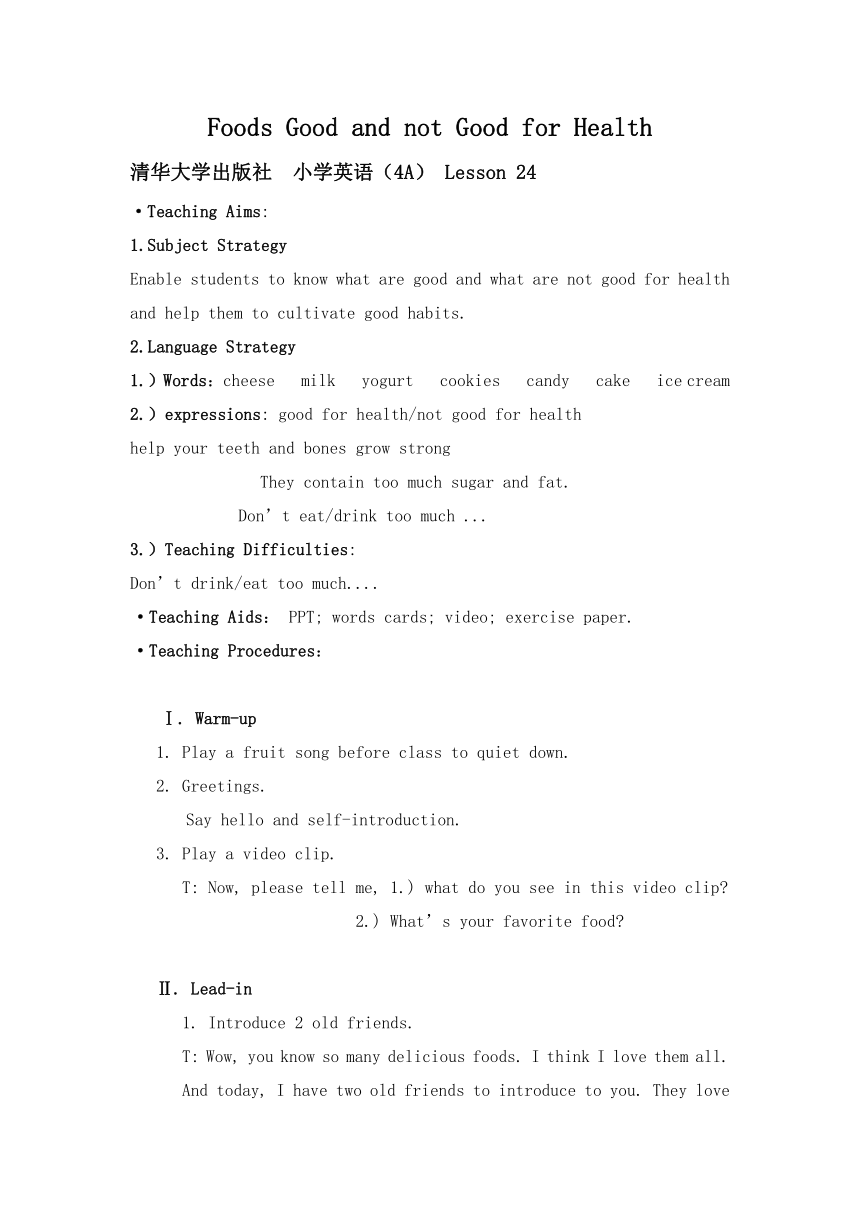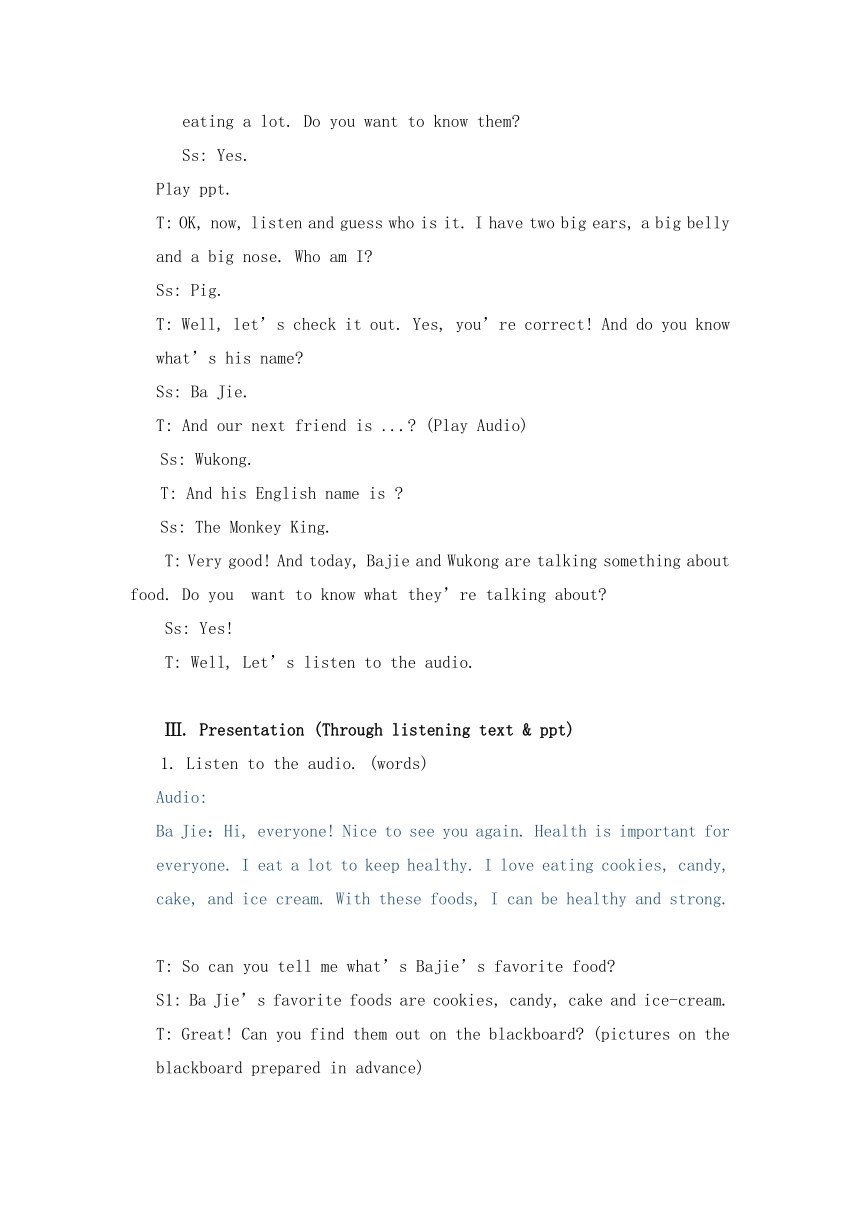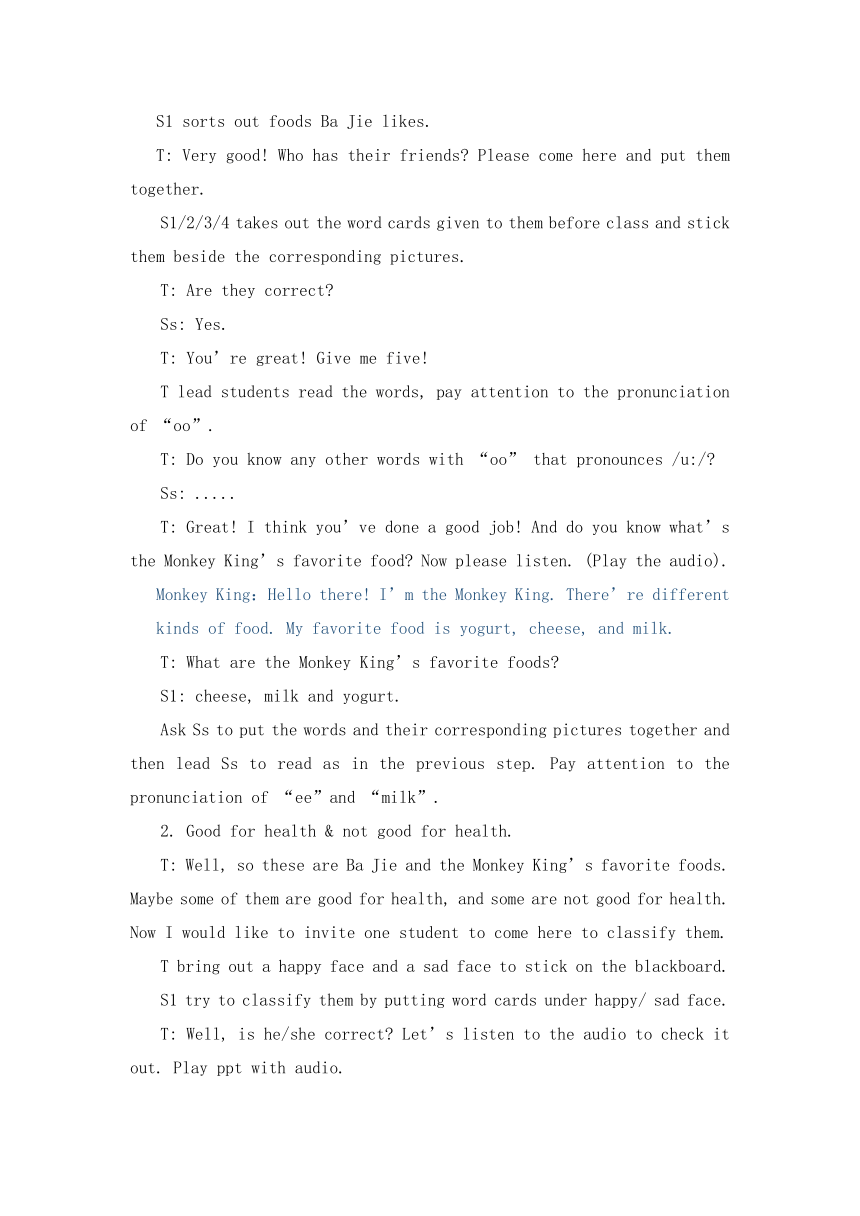Unit1 What are you going to do? Lesson4 全英文教案
文档属性
| 名称 | Unit1 What are you going to do? Lesson4 全英文教案 |  | |
| 格式 | doc | ||
| 文件大小 | 223.5KB | ||
| 资源类型 | 教案 | ||
| 版本资源 | 清华大学版 | ||
| 科目 | 英语 | ||
| 更新时间 | 2022-11-19 11:23:08 | ||
图片预览



文档简介
Foods Good and not Good for Health
清华大学出版社 小学英语(4A) Lesson 24
·Teaching Aims:
1.Subject Strategy
Enable students to know what are good and what are not good for health and help them to cultivate good habits.
2.Language Strategy
1.)Words:cheese milk yogurt cookies candy cake ice cream
2.)expressions: good for health/not good for health
help your teeth and bones grow strong
They contain too much sugar and fat.
Don’t eat/drink too much ...
3.)Teaching Difficulties:
Don’t drink/eat too much....
·Teaching Aids: PPT; words cards; video; exercise paper.
·Teaching Procedures:
Ⅰ. Warm-up
1. Play a fruit song before class to quiet down.
2. Greetings.
Say hello and self-introduction.
3. Play a video clip.
T: Now, please tell me, 1.) what do you see in this video clip
2.) What’s your favorite food
Ⅱ. Lead-in
1. Introduce 2 old friends.
T: Wow, you know so many delicious foods. I think I love them all. And today, I have two old friends to introduce to you. They love eating a lot. Do you want to know them
Ss: Yes.
Play ppt.
T: OK, now, listen and guess who is it. I have two big ears, a big belly and a big nose. Who am I
Ss: Pig.
T: Well, let’s check it out. Yes, you’re correct! And do you know what’s his name
Ss: Ba Jie.
T: And our next friend is ... (Play Audio)
Ss: Wukong.
T: And his English name is
Ss: The Monkey King.
T: Very good! And today, Bajie and Wukong are talking something about food. Do you want to know what they’re talking about
Ss: Yes!
T: Well, Let’s listen to the audio.
Ⅲ. Presentation (Through listening text & ppt)
1. Listen to the audio. (words)
Audio:
Ba Jie:Hi, everyone! Nice to see you again. Health is important for everyone. I eat a lot to keep healthy. I love eating cookies, candy, cake, and ice cream. With these foods, I can be healthy and strong.
T: So can you tell me what’s Bajie’s favorite food
S1: Ba Jie’s favorite foods are cookies, candy, cake and ice-cream.
T: Great! Can you find them out on the blackboard (pictures on the blackboard prepared in advance)
S1 sorts out foods Ba Jie likes.
T: Very good! Who has their friends Please come here and put them together.
S1/2/3/4 takes out the word cards given to them before class and stick them beside the corresponding pictures.
T: Are they correct
Ss: Yes.
T: You’re great! Give me five!
T lead students read the words, pay attention to the pronunciation of “oo”.
T: Do you know any other words with “oo” that pronounces /u:/
Ss: .....
T: Great! I think you’ve done a good job! And do you know what’s the Monkey King’s favorite food Now please listen. (Play the audio).
Monkey King:Hello there! I’m the Monkey King. There’re different kinds of food. My favorite food is yogurt, cheese, and milk.
T: What are the Monkey King’s favorite foods
S1: cheese, milk and yogurt.
Ask Ss to put the words and their corresponding pictures together and then lead Ss to read as in the previous step. Pay attention to the pronunciation of “ee”and “milk”.
2. Good for health & not good for health.
T: Well, so these are Ba Jie and the Monkey King’s favorite foods. Maybe some of them are good for health, and some are not good for health. Now I would like to invite one student to come here to classify them.
T bring out a happy face and a sad face to stick on the blackboard.
S1 try to classify them by putting word cards under happy/ sad face.
T: Well, is he/she correct Let’s listen to the audio to check it out. Play ppt with audio.
Hey, Bajie. I know you eat a lot. But do you know some foods help your teeth and bones grow strong, like yogurt, cheese and milk. Some foods are not good for health, like cookies, cake, candy and ice cream. They contain too much sugar and fat.
T: So now, who can tell me, what foods are good for health, and what foods are not good for health (T take out the word card of“good for health”& “not good for health”and stick them under the happy/sad face)
S1: ....... (Correct the classification on the blackboard if any).
T lead Ss together: Yogurt, cheese and milk are good for health, and cookies, cake, candy and ice cream are not good for health.
T takes the word cards of “good for health”& “not good for health”, lead Ss to read.
3. Learn the text.
T: Now please listen to the text again and try to answer my question: Why are some foods good for health And why are some foods not good for health
S1/2: .....
T reveal the answer through ppt and take out the key sentence card: help your teeth and bones grow strong/ They contain too much sugar and fat. Read and students follow.
T: So what should we do Can we eat too much of these kinds of food
Ss: No.
T: So don’t...
Ss: So don’t eat too much of these kinds of foods.
T: Do you know anything else we can’t eat too much
S1/2/3: .....
Ask students to read the text in groups.
Ⅳ. Practice
Target language:
1.) ..... Is/are good for health.
2.) ..... Is/are not good for health.
3.) Don’t .....
1. Lead students to express the target language through ppt. (pictures+sentence patterns).
1.) Milk is good for health. Coke is not good for health.
Don’t drink too much coke.
2.) Onions are good for health. Donuts are not good for health. Don’t eat too much donuts.
3. ) Corns are good for health. Chips and hamburgers are not good for health. Don’t eat too much chips and hamburgers.
4. ) Playing basketball is good for health. Watching too much TV is not good for health. Don’t watch too much TV.
2. Competition.
Ask the first student who raises hand to choose a number through ppt, which is linked to another ppt with a sentence. Ask students to judge weather its good or not good for health. Then T reveal the answer with happy or sad face.
1.) Eat an apple every day.
2.) Drink too much tea at night.
3.) Take a walk after dinner.
4.) Run after lunch.
5.) Eat too much candy.
6.) Wash hands before you eat.
T: Can you think of any other things good/ bad for health
3. Work in pairs.
1. Give students a text through ppt.
2. Show an example of how to fill in the blanks.
3. Ask students to make a survey with their desk-mates and then make a report.
Ask your desk-mate what he/she likes to eat and then fill in the blanks.
After the survey, you/ your desk-mate shall make a report.
_____ is my good friend.
He/ She likes __________________________.
I like ____________________.
We think ______________________ are good for health, and__________________ are not good for health. Don’t eat too much of these kinds of foods.
清华大学出版社 小学英语(4A) Lesson 24
·Teaching Aims:
1.Subject Strategy
Enable students to know what are good and what are not good for health and help them to cultivate good habits.
2.Language Strategy
1.)Words:cheese milk yogurt cookies candy cake ice cream
2.)expressions: good for health/not good for health
help your teeth and bones grow strong
They contain too much sugar and fat.
Don’t eat/drink too much ...
3.)Teaching Difficulties:
Don’t drink/eat too much....
·Teaching Aids: PPT; words cards; video; exercise paper.
·Teaching Procedures:
Ⅰ. Warm-up
1. Play a fruit song before class to quiet down.
2. Greetings.
Say hello and self-introduction.
3. Play a video clip.
T: Now, please tell me, 1.) what do you see in this video clip
2.) What’s your favorite food
Ⅱ. Lead-in
1. Introduce 2 old friends.
T: Wow, you know so many delicious foods. I think I love them all. And today, I have two old friends to introduce to you. They love eating a lot. Do you want to know them
Ss: Yes.
Play ppt.
T: OK, now, listen and guess who is it. I have two big ears, a big belly and a big nose. Who am I
Ss: Pig.
T: Well, let’s check it out. Yes, you’re correct! And do you know what’s his name
Ss: Ba Jie.
T: And our next friend is ... (Play Audio)
Ss: Wukong.
T: And his English name is
Ss: The Monkey King.
T: Very good! And today, Bajie and Wukong are talking something about food. Do you want to know what they’re talking about
Ss: Yes!
T: Well, Let’s listen to the audio.
Ⅲ. Presentation (Through listening text & ppt)
1. Listen to the audio. (words)
Audio:
Ba Jie:Hi, everyone! Nice to see you again. Health is important for everyone. I eat a lot to keep healthy. I love eating cookies, candy, cake, and ice cream. With these foods, I can be healthy and strong.
T: So can you tell me what’s Bajie’s favorite food
S1: Ba Jie’s favorite foods are cookies, candy, cake and ice-cream.
T: Great! Can you find them out on the blackboard (pictures on the blackboard prepared in advance)
S1 sorts out foods Ba Jie likes.
T: Very good! Who has their friends Please come here and put them together.
S1/2/3/4 takes out the word cards given to them before class and stick them beside the corresponding pictures.
T: Are they correct
Ss: Yes.
T: You’re great! Give me five!
T lead students read the words, pay attention to the pronunciation of “oo”.
T: Do you know any other words with “oo” that pronounces /u:/
Ss: .....
T: Great! I think you’ve done a good job! And do you know what’s the Monkey King’s favorite food Now please listen. (Play the audio).
Monkey King:Hello there! I’m the Monkey King. There’re different kinds of food. My favorite food is yogurt, cheese, and milk.
T: What are the Monkey King’s favorite foods
S1: cheese, milk and yogurt.
Ask Ss to put the words and their corresponding pictures together and then lead Ss to read as in the previous step. Pay attention to the pronunciation of “ee”and “milk”.
2. Good for health & not good for health.
T: Well, so these are Ba Jie and the Monkey King’s favorite foods. Maybe some of them are good for health, and some are not good for health. Now I would like to invite one student to come here to classify them.
T bring out a happy face and a sad face to stick on the blackboard.
S1 try to classify them by putting word cards under happy/ sad face.
T: Well, is he/she correct Let’s listen to the audio to check it out. Play ppt with audio.
Hey, Bajie. I know you eat a lot. But do you know some foods help your teeth and bones grow strong, like yogurt, cheese and milk. Some foods are not good for health, like cookies, cake, candy and ice cream. They contain too much sugar and fat.
T: So now, who can tell me, what foods are good for health, and what foods are not good for health (T take out the word card of“good for health”& “not good for health”and stick them under the happy/sad face)
S1: ....... (Correct the classification on the blackboard if any).
T lead Ss together: Yogurt, cheese and milk are good for health, and cookies, cake, candy and ice cream are not good for health.
T takes the word cards of “good for health”& “not good for health”, lead Ss to read.
3. Learn the text.
T: Now please listen to the text again and try to answer my question: Why are some foods good for health And why are some foods not good for health
S1/2: .....
T reveal the answer through ppt and take out the key sentence card: help your teeth and bones grow strong/ They contain too much sugar and fat. Read and students follow.
T: So what should we do Can we eat too much of these kinds of food
Ss: No.
T: So don’t...
Ss: So don’t eat too much of these kinds of foods.
T: Do you know anything else we can’t eat too much
S1/2/3: .....
Ask students to read the text in groups.
Ⅳ. Practice
Target language:
1.) ..... Is/are good for health.
2.) ..... Is/are not good for health.
3.) Don’t .....
1. Lead students to express the target language through ppt. (pictures+sentence patterns).
1.) Milk is good for health. Coke is not good for health.
Don’t drink too much coke.
2.) Onions are good for health. Donuts are not good for health. Don’t eat too much donuts.
3. ) Corns are good for health. Chips and hamburgers are not good for health. Don’t eat too much chips and hamburgers.
4. ) Playing basketball is good for health. Watching too much TV is not good for health. Don’t watch too much TV.
2. Competition.
Ask the first student who raises hand to choose a number through ppt, which is linked to another ppt with a sentence. Ask students to judge weather its good or not good for health. Then T reveal the answer with happy or sad face.
1.) Eat an apple every day.
2.) Drink too much tea at night.
3.) Take a walk after dinner.
4.) Run after lunch.
5.) Eat too much candy.
6.) Wash hands before you eat.
T: Can you think of any other things good/ bad for health
3. Work in pairs.
1. Give students a text through ppt.
2. Show an example of how to fill in the blanks.
3. Ask students to make a survey with their desk-mates and then make a report.
Ask your desk-mate what he/she likes to eat and then fill in the blanks.
After the survey, you/ your desk-mate shall make a report.
_____ is my good friend.
He/ She likes __________________________.
I like ____________________.
We think ______________________ are good for health, and__________________ are not good for health. Don’t eat too much of these kinds of foods.
